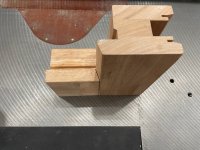Packard
Member
Cheese said:Packard said:Addendum: I just went to the Southern Pine Trade Association’s website and I see that they no longer list the QC as one of the benefits of adding the radii. Back when I read that description, it was the only reason cited for adding the radii.
I guess someone in marketing decided that they should only list the benefits to the consumers, and not to the lumber mills.
But be assured, back 10 or 15 years ago, when I read their website, the only benefit listed for the radii was speeding up the culling out of the undersized boards. Some of the benefits currently listed make little or no sense. Including the notion that it displaces the load more evenly.
In any case, they can change their minds on how to present this information, but they cannot change what I read. The only reason originally given was to speed up the removal of undersized lumber.
I'm sure what you read was correct at the time...15 years ago vision systems were expensive both to purchase and implement. Back then the human was the "vision system" and the radius was the identifier.
Fast forward to today and the vision systems have come down in price, some basic ones are available for around $1000. It doesn't take many hours of use to justify installing one of those as opposed to hiring another person.
Heck...the floor scrubbing machines at Menards all run autonomously using a vision system and a form of AI.
[attachimg=1]
[attachimg=2]
O.K., that makes sense. They really could not stop with the radii. Everyone would probably complain.
I am reminded of watching a boxing match probably sometime in the 1980s. The champion was well-known, but the challenger was not. I think the challenger was Hector Camacho, and all the ringside announcer knew about him was he was from Puerto Rico.
At the end of the fight the ringside announcer decided to make a fool of himself and asked (through a translator), “Did you become such a good fighter because you had to defend yourself on the streets of Puerto Rico?”
And the winner of the fight replied through that same translator, “No. I became a good fighter because I like to hurt people.”
He never repeated that, but it had the ring of truth.
In any case, the Souther Pine Association decided to generously continue with the radius on the edges so that people don’t hurt their hands. But, frankly the reason given 15 years back had the ring of truth.
Thanks for that technology perspective.
Packard







